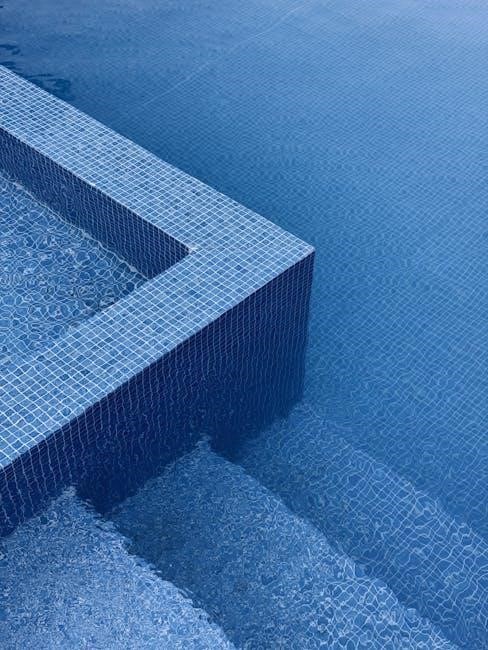Welcome to our comprehensive salt water pool maintenance guide․ Discover how to keep your pool clean, safe, and enjoyable․ Learn the essentials of maintaining saltwater systems, including monitoring salt levels, balancing water chemistry, and caring for equipment․ This guide provides step-by-step instructions to ensure optimal performance and longevity of your saltwater pool․
Understanding the Basics of Salt Water Pools
Salt water pools use a saltwater chlorine generator (salt cell) to convert salt into chlorine, naturally sanitizing the water․ Unlike traditional chlorine pools, salt water pools require specific maintenance to ensure the salt cell functions properly․ Salt levels must be monitored to maintain the ideal range of 2700-3400 ppm, with an optimal level of 3200 ppm․ The system produces chlorine naturally, reducing the need for manual addition of chlorine tablets․ Salt water pools are known for their gentler effects on skin and hair compared to traditional chlorine pools․ However, they still require regular maintenance, including cleaning the salt cell and monitoring water chemistry․ Understanding these basics is essential for keeping your salt water pool clean, safe, and enjoyable year-round․
Why Salt Water Pools Require Specific Maintenance
Salt water pools demand specific maintenance due to their unique system, which relies on a salt cell to generate chlorine․ Without proper care, the salt cell can degrade, leading to inefficient chlorine production and potential corrosion of metal components․ Additionally, imbalanced salt levels can disrupt the chlorine generation process, affecting water quality․ Regular maintenance ensures the longevity of the salt cell and other equipment, preventing costly repairs․ Proper upkeep also maintains water chemistry, ensuring a safe and healthy swimming environment․ Neglecting maintenance can result in cloudy water, algae growth, and equipment damage, making routine tasks essential for optimal performance and enjoyment of your salt water pool․

Daily and Weekly Maintenance Tasks

Consistent daily and weekly maintenance ensures your salt water pool remains clean and safe․ Tasks include skimming, brushing, testing salt levels, and adjusting chlorine levels as needed regularly;
Skimming and Brushing the Pool
Skimming and brushing are essential daily tasks for maintaining a clean and healthy salt water pool․ Use a long-handled skimmer to remove floating debris like leaves and insects from the surface․ This prevents dirt from sinking and causing cloudy water; Additionally, brush the pool walls, steps, and floor to remove algae and stains․ Focus on areas with poor water circulation․ Regular brushing helps prevent algae growth and keeps the pool looking pristine․ For best results, skim the pool every day and brush it at least twice a week․ This routine ensures your pool remains clean, hygienic, and visually appealing throughout the season․
Testing Salt Levels and Adjusting as Needed
Regularly testing and adjusting salt levels is crucial for maintaining your salt water pool․ Salt levels should be between 2700-3400 ppm, with the ideal level at 3200 ppm; Use a salt test kit or digital meter to monitor concentrations․ Low salt levels can reduce chlorine production, while excessively high levels may damage equipment․ Test salt levels weekly and adjust as needed by adding pool salt or diluting with fresh water․ Remember, salt is typically added once or twice a year, except when opening the pool․ Proper salt balance ensures efficient chlorine generation, clear water, and system longevity․ This simple step is vital for maintaining a healthy and enjoyable swimming environment․
Monitoring Chlorine Levels
Monitoring chlorine levels in a saltwater pool is essential to ensure clean, safe, and healthy swimming conditions․ Unlike traditional pools, saltwater pools generate chlorine naturally through the salt cell․ Test chlorine levels 1-2 times a week using test strips or a digital tester․ Ideal chlorine levels should be between 1-3 ppm․ Low chlorine levels can lead to cloudy water and bacterial growth, while excessively high levels may cause eye irritation or damage to equipment․ Adjust chlorine levels by modifying the salt cell settings or adding stabilizers as needed․ Regular testing ensures balanced water chemistry, protects swimmers’ health, and maintains the efficiency of your saltwater pool system․ Proper chlorine levels are vital for a safe and enjoyable swimming environment․

Monthly Maintenance Procedures
Regular monthly tasks ensure your saltwater pool remains clean and functional․ Clean the salt cell with muriatic acid, backwash the filter, and inspect equipment for damage or wear․
Cleaning the Salt Cell
Cleaning the salt cell is essential for maintaining your saltwater pool’s chlorine production․ Start by turning off the pool equipment for safety․ Remove the salt cell and inspect it for buildup or corrosion․ Mix a solution of muriatic acid and water, following the manufacturer’s recommended ratio․ Soak the salt cell in the solution to help break down any scaling․ Use a soft-bristled brush to gently scrub away stubborn deposits, ensuring not to scratch the cell’s surface․ Rinse thoroughly with water from a garden hose to remove all acid residue․ If buildup is severe, repeat the process as needed․ Always wear protective gloves and eyewear when handling acid․ After cleaning, check the chlorine levels to ensure the cell is functioning properly․ Dispose of the acid solution responsibly, neutralizing it before disposal if possible․ Regular cleaning, ideally every one to three months depending on usage, will help maintain the salt cell’s efficiency and extend its lifespan․
Backwashing the Filter
Backwashing the filter is a crucial maintenance task for your saltwater pool․ It involves reversing the flow of water through the filter to remove trapped debris and contaminants․ Start by turning off the pool pump to ensure safety․ Locate the backwash valve, typically found near the filter, and set it to the “backwash” position․ Turn the pump back on and allow it to run until the water in the sight glass becomes clear, usually 2-3 minutes․ Turn off the pump again and reset the valve to its normal position․ For cartridge filters, remove and rinse the cartridge with a garden hose if needed․ Regular backwashing, ideally once a week or when pressure increases, ensures optimal filtration and prevents damage to the system․ Neglecting this step can lead to poor water quality and reduced equipment efficiency․
Inspecting Pool Equipment
Regularly inspecting your pool equipment is essential for maintaining a saltwater pool․ Check the salt cell, pumps, filters, and valves for any signs of wear or damage․ Ensure all connections are secure and free from leaks; Inspect the condition of hoses and gaskets, replacing them if necessary․ Pay attention to the pump motor and electrical components for proper function․ Lubricate moving parts as recommended by the manufacturer․ Also, examine the pool’s control systems and sensors to ensure they are operating accurately․ Regular inspections help prevent unexpected malfunctions and prolong the lifespan of your equipment․ Neglecting this step can lead to costly repairs and disruption in your pool’s operation․ Schedule inspections monthly or whenever you notice unusual performance to maintain optimal functionality․

Seasonal Maintenance
Seasonal maintenance ensures your saltwater pool remains functional year-round․ Clean the salt cell, backwash the filter, and winterize the system․ Test salt levels and balance water chemistry regularly․
Opening the Pool for the Season
Opening your saltwater pool for the season involves several key steps to ensure it operates efficiently․ Start by testing and adjusting the salt levels, aiming for the recommended range of 2700-3400 ppm․ Check the chlorine levels and balance them if necessary․ Clean the pool floor, walls, and steps using a pool brush, and skim any debris from the surface․ Inspect the salt cell for any damage or scaling and clean it if needed․ Perform a partial drain if the salt levels are too high․ Finally, test the pH and alkalinity levels and adjust them to maintain proper water balance․ Regular maintenance during the season will keep your pool clean, safe, and enjoyable for swimming․
Closing the Pool for Winter
Closing your saltwater pool for winter requires careful preparation to protect the system and ensure it remains in good condition․ Start by testing and adjusting the salt levels, ensuring they are within the recommended range of 2700-3400 ppm․ Clean the pool thoroughly, removing debris and brushing the walls and floor․ Balance the water chemistry, including pH and alkalinity, to prevent corrosion and scaling․ Drain the water to the recommended winter level, usually below the skimmer and return jets, to avoid freezing damage․ Winterize the plumbing by draining or using a winterizing kit; Finally, cover the pool with a high-quality winter cover to keep out debris and contamination․ Proper winterization will save time and money when reopening the pool in the spring․
Winterizing the Saltwater Pool System
Winterizing your saltwater pool system is crucial to prevent damage from freezing temperatures and corrosion․ Start by cleaning the filter and draining it, or use a winterizing kit to protect it from ice․ Disconnect and store any external equipment, such as the salt cell, to avoid exposure to harsh weather․ Use a pool antifreeze or apply a winterizing solution to the plumbing lines to safeguard against freezing․ Ensure the pool cover is secure to prevent debris accumulation․ Lastly, inspect all components for potential damage before the winter season begins․ Proper winterization extends the lifespan of your saltwater pool system and ensures smooth operation when reopening in spring․
